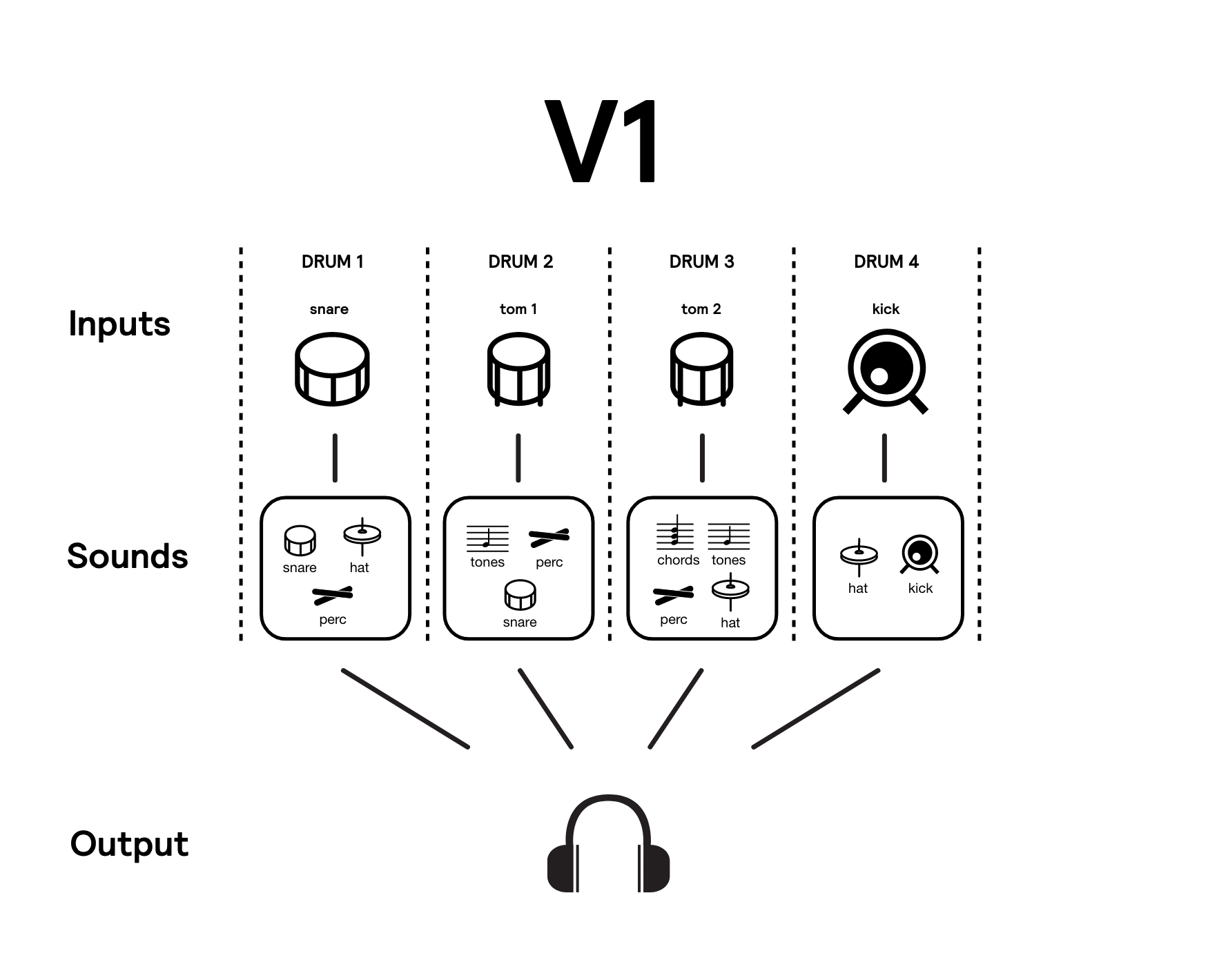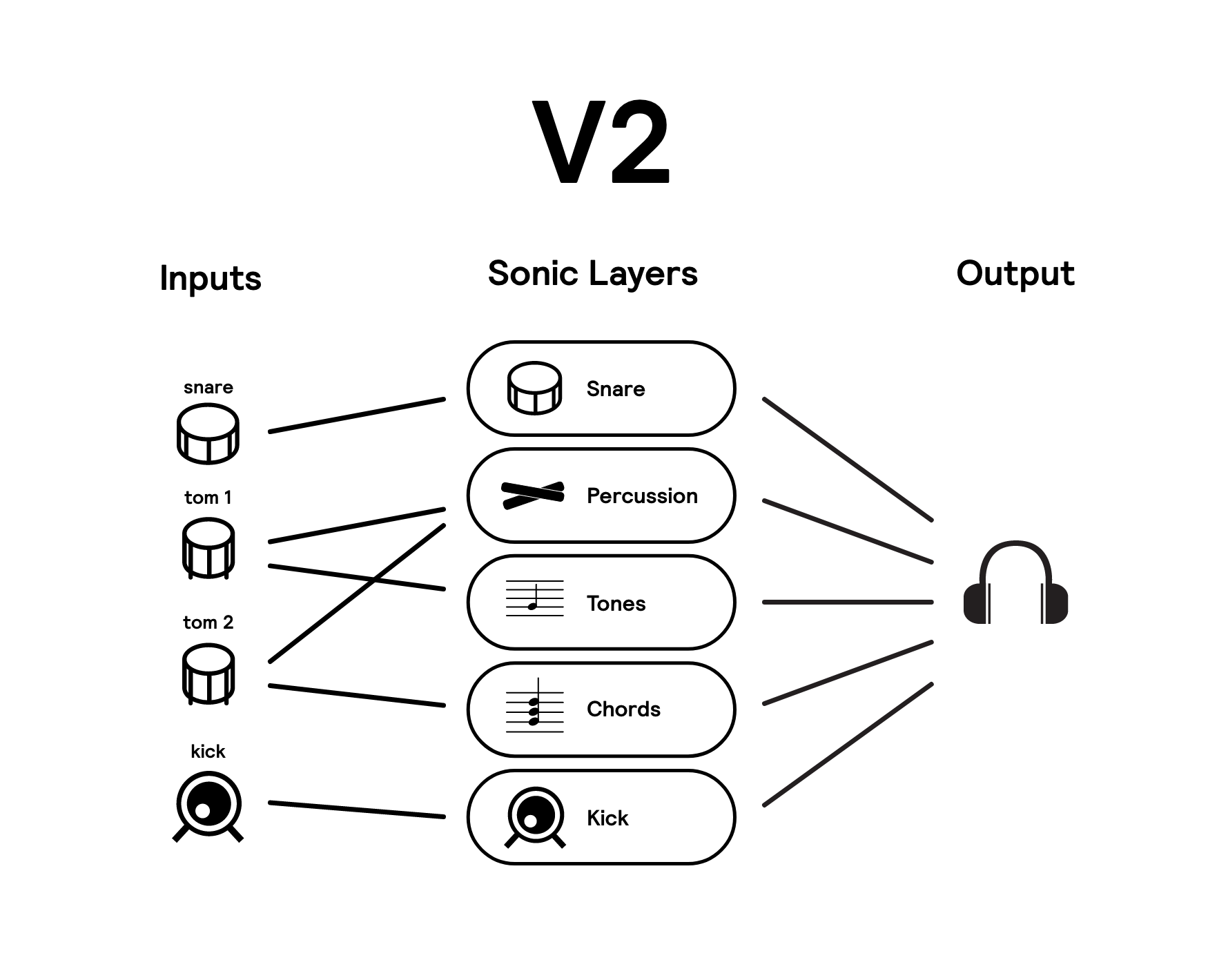Software Concepts
Sensory Percussion v2 is a completely new piece of software. Our goal with this new version is to embrace a modular design that truly lets users design sets however they like. Want to make something super simple and just drag samples into our multi-zone pads? That’s easier than ever. Want to create something complicated with nested sequencers and tons of controllers? That’s now possible in a way that never was before.
Untethering Sounds from Inputs
One of the biggest changes from V1 to V2 has to do with the signal path from input --> sound --> output. Below is a diagram of the path in V1:

In this model, you can't create sounds independently from the drum that's controlling them. Any sound you add to a kit is restricted to one of 4 input channels, and therefore can't be shared across more than one. So, if you want the same sounds on multiple drums, you'd have to copy/paste them, resulting in duplicate samples.
Additionally, even though one drum might contain many different kinds of sounds (chords, snare, percussion, etc.), they can't be mixed independently. So, any processing you do to one set of sounds will affect all of the sounds on that channel. Now, let's take a look at the new structure of V2:

This new structure is centered around a concept we call layers. Layers are a way to organize your musical ideas. You're no longer forced to think in terms of mixer channels and how sounds will be routed to speakers. Instead, you can start building your musical idea first and then decide how you want to control it later.
In addition to a more flexible workflow, sonic layers also allow for more mixing options. Because you can now organize your sounds in the same way a composer would write for an orchestra, you can also mix this way. In the example above, tom 2 is controlling both chords and percussive layers. You can make mixing changes to the chords without affecting the percussive sounds, even if they're both assigned to the same zone of tom 2.
With this new structure, the musical idea is front and center, regardless of the physical setup!
Modular Structure
Modules are the building blocks of Sensory Percussion v2, so understanding how they interact is important for building your own sounds.
Essentially, anything you drag in from the library is a module--whether it's a generator that actually provides sound, a controller that affects the relationships between sounds, or an effect, which manipulates an existing sound. A basic example of how two modules interact would be taking a sampler module and putting it inside of a note controller module. Now, the sampler inside of the note controller is being pitched to the notes you choose based on velocity, speed, or timbre.
Next, this note controller module can go inside of another controller, such as a sequencer. Now, both of the previous modules are just one step of a sequence. The other steps can be individual samplers or other controllers. This structure allows for what is called "nesting," which is essentially when you put one controller inside of another. For example, you could put a sequencer inside of another sequencer or a group inside of a group, quickly creating a variety of complex combinations of sounds.
This structure is also useful for organizing complex sets into a format is visually easily digestible. You might have a complex system of modules and controllers all interacting with each other on multiple layers in your set, but you can always right-click the top module, select "Group into...," and put everything you want into a single module, such as a drum pads module, to distribute the sounds across the zones of a single drum.
Here is a list of the module categories:
- Generator modules, which make sound or send a MIDI message, like samplers. Generator modules can’t contain other modules.
- Controller modules, which help you organize and route other modules in powerful ways. These modules let you create sequences, melodies, and chords. Controller modules can contain any other kind of module, for example, sequencers can contain other sequencers.
- And finally, there are Effect Modules, like reverbs, delays, and the like. Every Generator or Controller module type has slots for effects.